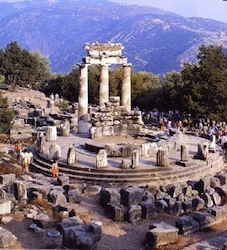
In a long room in the museum, the Classical bureau, which is directed by archaeologist Athanasia Psalti, has set up an exhibition of 40 stone steles ranging from the Archaic period to the first years of Christianity, representing just a small part of the many epigraphs discovered during excavations in the area.
The epigraphs of the Delphic sanctuary were numerous and had an important role in the functioning of the site. Those exhibited in the new show, the archaeologist says, are among the most significant evidence unearthed and give a clear picture of all categories of inscriptions covered. The epigraphs on display include some of the most important resolutions decided by representatives of the 12 tribes that lived in the surrounding regions during assemblies held in summer and in autumn, the ”Ieromimnones”.
Inscriptions to cities, kings and emperors can also be admired, as well as those for sporting events held in the stadium that would be the setting for the Pythian Games, which were held three years after the Olympics and take their name from Pythia, the priestess who pronounced the oracles in the name of Apollo.
The epigraphs with incisions of accounts include a record of funds for the reconstruction of the Sanctuary of Apollo around the second half of the 6th century BC. Among the most significant incisions is the famous antique maxim ”Know Thyself” (”Gnothis eauton”) which figured on the architrave at the entrance of the Temple of Apollo, inside of which burned the ”eternal flame”. There are also a number of incisions referring to acts of liberation of slaves, while educational programmes, as Psalti explains, evoke people who had really existed, such as the philosopher Aristotle, or mythological figures such as the nymph Castalia.
The choice of pieces to be exhibited was made by the French epigraphist, Dominique Mulliez, who until last year was the director of the French School of Athens and is today a professor of Greek Civilisation at the Sorbonne University in Paris.
(source: ANSA)
See all the latest news from Greece and the world at Greekreporter.com. Contact our newsroom to report an update or send your story, photos and videos. Follow GR on Google News and subscribe here to our daily email!



